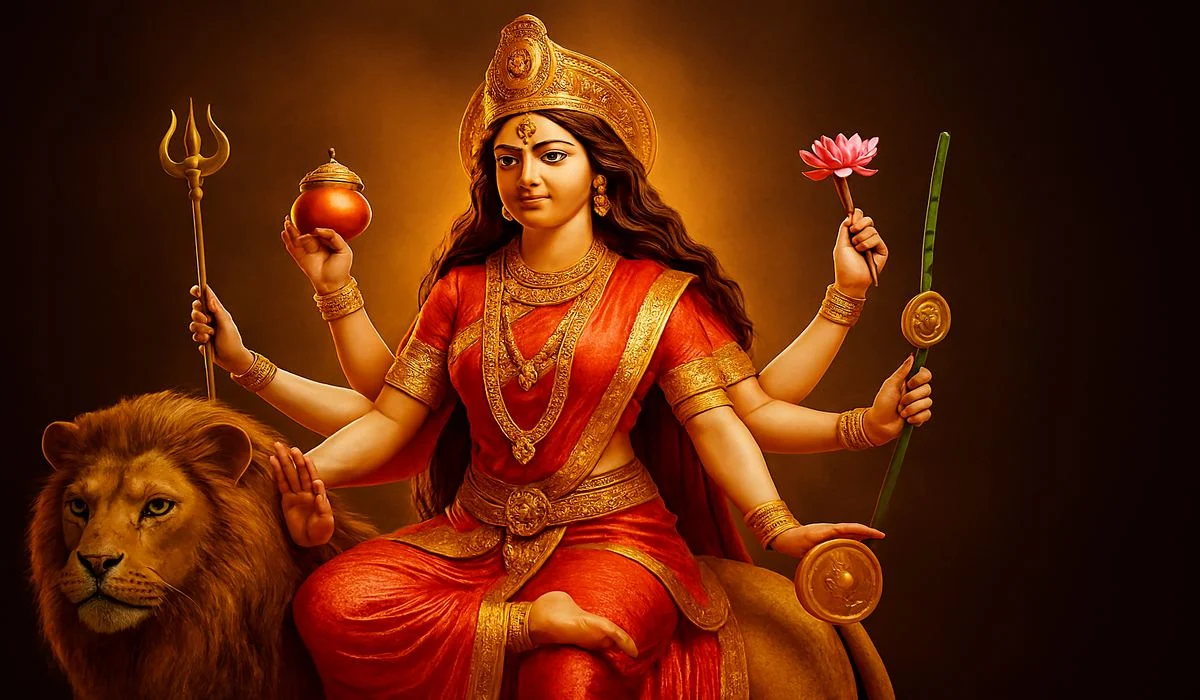Maa Kushmanda, the divine feminine superpower who is accredited with creating the universe is worshipped on the fourth day of Navratri, the nine day long festival. Maa Kushmanda, is considered the divine mother. Her radiant smile is believed to heal everyone and everything. As each day of Navratri is dedicated to a different form or roop of Maa Durga, the fourth day or Chaturthi of Navratri 2025 is dedicated to Maa Kushmanda.
Maa Kushmanda gets her name “Kushmanda” from amalgamation of three Sanskrit words which are—Ku which means little, Ushma which means warmth or glow of sun or even energy and Anda which here symbolises a divine egg. Thus, when the three words combine, they together form the name with which we address the divine creator goddess: Maa Kushmanda. The three words combined together mean “the one who created the universe with a little cosmic energy” and as she is believed to be the creator of the cosmos, she was named so.
As per old belief and the scriptures of the Hindu mythology found, this form of Maa Durga is the origin and source of all forms of life, light, radiance and glow. It is believed that as her habitat is the sun, thus she emanates divine endless energy which gives life to everything and thus she is the supreme, glowing creator and mother of the cosmos and everything cosmic. Maa Kushmanda is the source of life and light, and her blessings bring health, happiness, and prosperity.
Importance and significance of Maa Kushmanda
Maa Kushmanda is also fondly known as the divine creator, the creator of the universe and the cosmos. As per mythological tales, before the creation and birth of the universe, there was no light, everything was pitch dark. It is said that as Maa Kushmanda had the most beautiful, power, radiant smile she generated a warm cosmic egg (anda) which alongwith the energy and warmth of sun grew and expanded into this cosmos or universe.
She has a divine radiance, her divine aura, her radiant spirit is the epitome of the power of all sources of energy, which is the Sun. And thus it is belief amongst her devotees that worshipping this devi roop will bring new life, new beginnings, energy, long life, strength, exuberance and positivity.
Maa is seen riding a lion (her sawari is a lion). This is also a symbolic representation of She is depicted riding a lion, signifying bravery, fearlessness, power and heroism. Maa is depicted to have eight hands and each of her hands are seen holding a different item. One hand holds the kamandal (sacred water pot), one holds the bow, one an arrow, one a lotus (kamal), one a mace (a heavy club with a spiked metal head), one a chakra, one a rosary and one hand has a jar of amrit(nectar). Each item has a different meaning and symbolic significance of new life, power, strength, courage, victory of good over evil, positivity, spiritual connection and faith.
Puja Vidhi and rituals
Anyone who is observing the auspicious festival of Navratri , should perform the puja of Maa Kushmanda on the Day 4 of Navratri. It is believed that praying to this roop of Maa Durga will bring positivity, new beginnings and prosperity.
Here is how you can perform puja, or the puja vidhi:
- Anyone observing the festival and puja should wake up early and take a bath. Before performing the rituals, you should place the idol of the Goddess in a clean space which should face east or the rising sun.
- If you are observing the whole nine day or 10 day long Navratri, you can establish Kalash at your home on Day 1 of Navratri which is known as Kalash Sthapna. A kalash (pot) filled with ganga jal(holy water), some coins, haldi(turmeric) and kumkum (vermillon) should be placed. 5 leafed mano leaves and coconut should be placed on it.
- Ghee diyas (small lamps) and dhoop (incense) are lighted in front of the idol. Arhul ke phool(hibiscus flowers), fruits and panchamrit (sacred 5 ingredient offering) is offered to the Goddess.
- Reciting Mantras and chants dedicated to Maa Kushmanda is recommended to help attract divinity and positivity.
- Many followers and devotees observe fasts wither for the whole 9 day or 10 day Navratri period or for 2 days or on any day which they have promised Maa that they will do so. Many have only fruits, water and other fruit juices during the whole Navratri. Some also have vrat (fasting) food like kuttu, sabudana, sendha namak, nuts etc.
Mantras of Maa Kushmanda
To imbibe the blessings of Maa, the following Mantras can be chanted with devotion and the faith that Maa is listening to you, and will bring happiness, mental peace, positivity, longevity and new beginnings of life:
Navdurga Mantra:
ॐ देवी कूष्माण्डायै नमः॥
(Om Devi Kushmandayai Namah)
Dhyana Mantra:
सुरासम्पूर्णकलशं रूधिराप्लुतमेव च।
दधाना हस्तपद्माभ्यां कूष्माण्डा शुभदास्तु मे॥
Colour of the Day
The fourth day of Navratri is associated with the colour yellow. The colour yellow is a token of new life, radiance, positivity, brightness and happiness. signifies positivity, glory, brightness and happiness. Just like the colour yellow, worshipping and praying to Maa and wearing yellow coloured clothes on this day will bring much happiness, glory, joy and lots of cheer and remove any negativity.
Conclusion
Maa Kushmanda is the fourth roop/ avatar or form of Maa Durga. Maa Durga is the supreme divine feminine power and just like her Maa Kushmanda also personifies creation, life, energ , light and radiance. the fourth form of Goddess Durga, embodies creation, energy, and light. As Maa is the creator, she has the power to bless you with anything and evrything that is new, fresh and bright, this includes good health, wealth, prosperity, positivity, happiness and mental and spiritual peace. Praying to Maa on any day will bless your inner and outer self.
